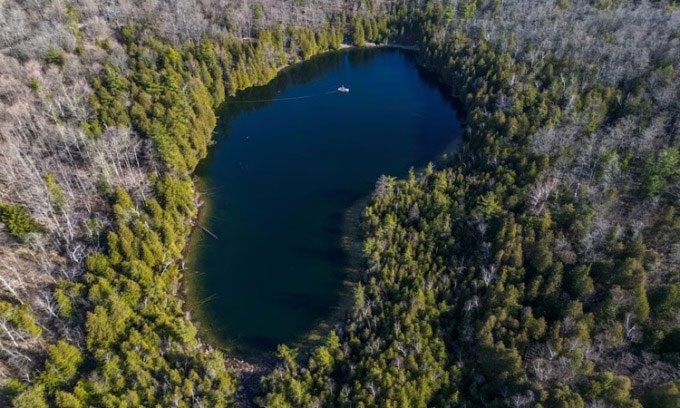Crawford Lake in the suburbs of Canada has been chosen as a symbol for the beginning of a new chapter in Earth’s history known as the Anthropocene, or the age of humans.
On July 11, an international team of scientists announced that the clearest evidence of human impact on Earth is found at Crawford Lake in Milton, Ontario. The lake’s layered sediments contain millennia of information about environmental history, leading to an explosion of artificial impact around the mid-20th century. This era marks when human activities, from nuclear weapon testing and burning fossil fuels to deforestation and global trade, began to leave an indelible mark on the geological history of the planet.

Crawford Lake in Ontario, Canada, is a golden marker of the Anthropocene. (Photo: Bonnie Jo Mount/The Washington Post)
The announcement marks a significant step in a years-long effort to determine whether humans have altered the planet enough to create a new geological epoch. Since 2009, a scientific organization called the Anthropocene Working Group has been gathering chemical and climatic evidence that differs from conditions thousands of years ago. The ultimate goal is to identify a “golden spike,” a specific point in geological history that perfectly preserves the dangerous changes caused by humans.
Crawford Lake reflects various components of the Earth system and how they interact with each other in ways that differ from the past, according to Francine McCarthy, a professor of Earth sciences at Brock University in Ontario and the lead researcher on the lake study. They believe it is the best location to demonstrate this issue. Before the Anthropocene is added to Earth’s 4.6 billion-year timeline, the decision must undergo scrutiny from the geological community. In the coming months, the proposal will be submitted to the Quaternary Stratigraphy Commission, which is responsible for dividing the history of the last 2.4 million years. Subsequently, the International Union of Geological Sciences will vote on it. If it passes these stages, the proposal will be approved at the International Geological Congress in South Korea.
Crawford Lake was selected from 12 golden spike candidates worldwide, including ice in Antarctica, two remote coral reefs, a mountaintop peat bog, and a polluted marine bay in California. Each piece of evidence of human-caused pollution surged around 1950, particularly the sudden increase in radioactive plutonium from nuclear weapon testing, which will serve as a fundamental marker for the Anthropocene.
After months of careful consideration, 22 voting members of the group, including McCarthy and Colin Waters, a geologist at the University of Leicester and chairman of the Anthropocene Working Group, determined that Crawford Lake holds evidence of the Anthropocene more distinctly than any other location. In addition to radioactive dust, the lake also contains signs of industrial pollution, species extinction, and global climate change. Tiny black particles known as fly ash, a byproduct of fossil fuel combustion, are scattered throughout the sediments. Changes in the types of pollen buried indicate how the surrounding forest responded to gradually increasing temperatures.
However, not all scientists agree that the Anthropocene belongs on the geological timescale. Other epochs were named millennia after they occurred. They are defined not by instrumental data and eyewitness accounts but by environmental changes preserved in rock, tree rings, sediments, and ice. A cliff in Tunisia contains evidence of an ancient meteorite impact marking the end of the dinosaur era. The beginning of the Holocene epoch started 11,700 years ago, marked by hydrogen molecules trapped in ancient ice in Greenland.
Some researchers are concerned that a strict geological definition of the Anthropocene could have ripple effects beyond academia. For example, according to Andrew Bauer, an anthropologist at Stanford University specializing in human-environment interactions, defining the mid-20th century as the start of the Anthropocene might downplay the impact humans had prior to that time. On the other hand, the term “Anthropocene” implies that everyone shares equal responsibility for planetary changes, whereas research indicates that the wealthiest nations contribute the most to carbon emissions and cause significant environmental harm.


















































